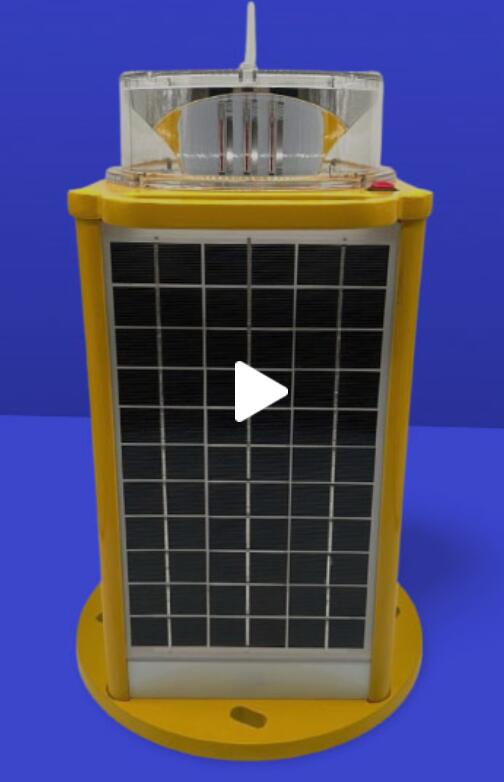Solar Powered Aviation Light: The Future of Eco-Friendly Obstruction Lighting
As global aviation traffic increases and environmental concerns grow, the solar powered aviation light has emerged as a sustainable solution for marking aerial obstacles. These innovative devices combine renewable energy with advanced lighting technology to enhance aviation safety while reducing carbon footprints. This article examines the critical role of solar powered aviation lights in modern airspace management, their technological advantages, and their growing adoption across various industries.
The Critical Need for Solar Powered Aviation Lights
With air traffic projected to double by 2040 and urban structures reaching unprecedented heights, reliable obstruction lighting has never been more essential. Solar powered aviation lights address this need by providing:
Uninterrupted operation regardless of grid availability

Superior visibility in all weather conditions
Compliance with international aviation regulations
| solar powered aviation light |
Reduced environmental impact compared to conventional systems
These lights are particularly crucial for marking:
Communication towers
Wind turbines
High-rise buildings
Construction cranes
| solar powered aviation lights |
Transmission lines
How Solar Powered Aviation Lights Work
The operational efficiency of solar powered aviation lights stems from their intelligent design:
Energy Harvesting System
High-efficiency photovoltaic panels
Maximum power point tracking (MPPT) technology
Weather-resistant solar cell configurations
Power Management
Deep-cycle battery storage
Smart charge controllers
Low-voltage disconnect protection
Lighting Technology
High-intensity LED arrays
Adaptive brightness control
Multiple flash patterns (ICAO/FAA compliant)
Autonomous Operation
Light sensors for automatic dusk-to-dawn operation
Self-diagnostic systems
Remote monitoring capabilities
Technological Advancements in Solar Powered Aviation Lights
Recent innovations have significantly enhanced the performance of solar powered aviation lights:
Hybrid Power Systems: Combining solar with alternative renewable sources
Advanced Materials: Using graphene-enhanced batteries and nano-coated solar cells
Smart Connectivity: IoT-enabled devices for real-time status monitoring
Enhanced Durability: Military-grade components for extreme environments
Adaptive Lighting: AI-powered intensity adjustment based on visibility conditions
These developments have extended operational lifespans while reducing maintenance requirements.
Regulatory Compliance and Industry Standards
Solar powered aviation lights must meet stringent international requirements:
ICAO Standards (Annex 14):
Light intensity classifications (L-864, L-810, etc.)
Color specifications (red/white)
Flash characteristics
FAA Regulations (AC 70/7460-1K):
Obstruction lighting requirements
Photometric performance
Physical durability standards
IEC Certification:
Environmental testing (IP ratings)
Electrical safety
Electromagnetic compatibility
Compliance ensures reliable performance across different geographical and climatic conditions.
Applications Across Industries
The versatility of solar powered aviation lights makes them indispensable for:
Aviation Sector
Airport perimeter lighting
Approach path indicators
Temporary obstacle marking
Renewable Energy
Wind farm obstruction lighting
Solar farm markers
Hydroelectric dam warnings
Urban Infrastructure
Skyscraper lighting systems
Bridge illumination
Construction site safety
Telecommunications
Cell tower markers
Broadcast antenna lighting
Microwave relay station warnings
Environmental and Economic Benefits
The adoption of solar powered aviation lights offers significant advantages:
Carbon Footprint Reduction: Eliminates reliance on fossil fuel-generated electricity
Energy Independence: Operates in remote locations without grid access
Lower Operational Costs: Minimal maintenance and no electricity bills
Scalability: Easy to deploy and relocate as needed
Future-Proofing: Aligns with global sustainability initiatives
Future Trends in Solar Aviation Lighting
Emerging technologies will further revolutionize solar powered aviation lights:
Quantum Dot Solar Cells: Boosting energy conversion efficiency
Solid-State Batteries: Extending operational life in cold climates
Machine Learning Algorithms: Predictive maintenance and performance optimization
Integrated Radar Reflectors: Enhancing visibility for all weather conditions
Modular Designs: Allowing customized configurations for specific applications
The solar powered aviation light represents a perfect synergy between aviation safety and environmental responsibility. As technology continues to advance, these systems will become even more efficient, reliable, and indispensable for global airspace management. Their adoption across multiple industries demonstrates a collective commitment to safer skies and a more sustainable future.
For aviation authorities, construction firms, and infrastructure developers, investing in solar powered aviation lights is not just about regulatory compliance - it's about embracing innovative solutions that protect both people and the planet. As we move toward greener technologies in all sectors, these lights will undoubtedly play an increasingly vital role in global aviation safety systems.
